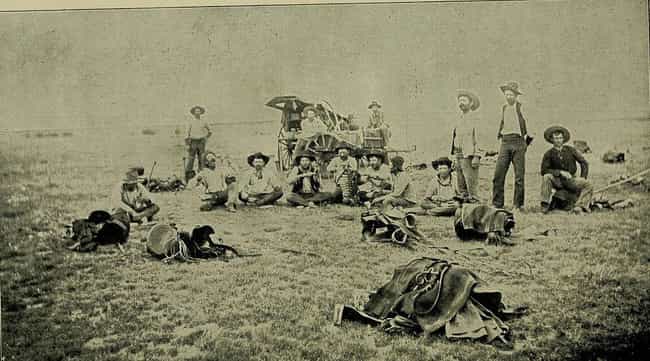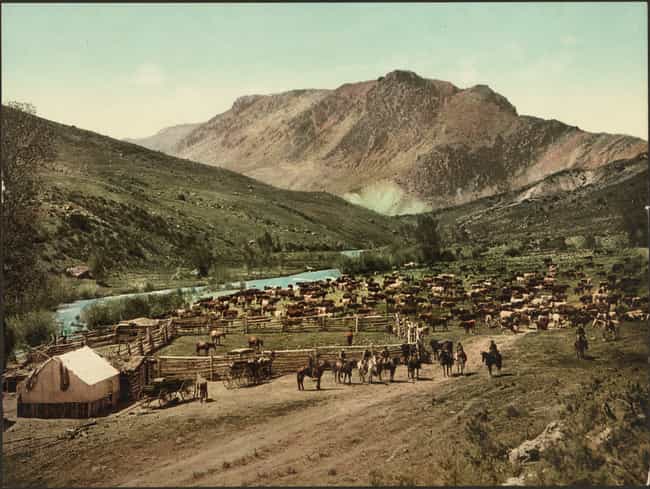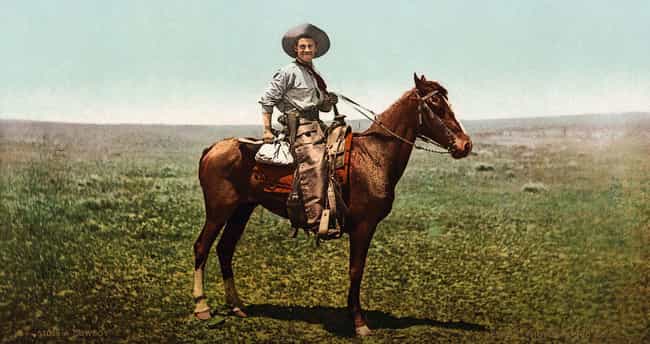In contrast to much of what Hollywood has constructed, the real cowboy lifestyle was far less glamorous and happy than you may think. Of course, there were some smiling faces among 19th century cowboys, but the gunslinging frontier hero you may picture is a Wild West myth.
Cowboys in the old American West worked cattle drives and on ranches alike, master horsemen from all walks of life that dedicated themselves to the herd. Cowboy life in the 1800s was full of hard work, danger, and monotonous tasks with a heaping helping of dust, bugs, and beans on the side.
Cowboys Didn’t Get A Lot Of Sleep

A cowboy’s day and night revolved around the herd, a constant routine of guarding, wrangling, and caring for cattle. When cowboys were out with a herd or simply working on a ranch, they had to be on watch. With a typical watch lasting two to four hours, there was usually a rotation of men. This gave cowboys the chance to sleep for relatively short spurts, often getting six hours of sleep at the most.
Cowboys slept on bedrolls, an easily transportable mattress of sorts made out of feathers, canvas, or waterproof tarpaulin. Out on a drive, cowboys slept on the same bedrolls they used at the ranch. Bedrolls were likely full of lice and bedbugs wherever they were used.
Dirt Was Everywhere

Cowboys out with the herd wore the same clothes day in and day out. While wrangling the herd, cowboys in the back were naturally surrounded by a giant dust cloud stirred up by the animals, but dirt was pretty inescapable from any vantage point.
When cowboys were done with a cattle drive or came to a town, they made their way to a much needed and enjoyed bath. They may have also purchased new clothes and blown off steam at the local saloon.
Life at a ranch could have been less dusty, but not always. Some ranches had elaborate mansions but cowboys spent their days and nights in bunkhouses and other outbuildings. These were modestly better than being out on the range but a lot of cowboys preferred to sleep out under the stars even when they had the option of a roof over their heads.
They Had Their Own Language

The language of cowboys was full of task-specific phrases – and a fair amount of cursing. Much of the cowboy lexicon came from the vaquero tradition, but there was a lot of slang, too.
Cowboys used metaphorical phrases like “above snakes” or “hair case” to indicate being alive and a hat, respectively. They also used Native American words as they interacted with individual tribes.
Cowboys had words for their guns, their horses, the types of work they did, and their gear. A rope could be called many things based on what it was made of and what it looked like. For example, a long black and white horse hair rope was called a “pepper-and-salt rope.”
Their Clothes Were Practical And Protective

Cowboys wore hats, chaps, boots, and other hardy clothing to keep themselves safe on the trail and in the harsh elements. Hats varied by region but generally they had brims to keep the sun out of cowboys’ eyes. The wider the hat brim, the more shade it could provide.
Chaps were worn over pants to keep cowboys’ legs safe and American cowboys wore bandanas around their necks they could pull over their mouths and noses to keep the dust out.
Cowboy boots were designed with narrow toes and heels so the cowboy’s foot would fit securely in a stirrup but still have the ability to move should the rider need to dismount. Made of leather, they were sturdy and had spurs attached so a cowboy could prod his horse along. Boots were tall, going up the lower leg of a cowboy for protective purposes.
Strength, Courage, And Intelligence Were Equally Essential To Survival

Contemporaries heralded cowboys’ “courage, physical alertness, ability to endure exposure and fatigue, horsemanship, and skill in the use of the lariat.”
Cowboys needed to be physically strong to take on tasks like breaking horses, roping cattle, and riding for hours on end. Courage to chase down stampeding herds or brave the elements on a regular basis was supplemented by the knowledge required to make quick decisions, care for the cattle, and not panic in the face of a crisis.
Often this intelligence came with years of experience, but cowboys needed to be able to understand cow psychology, navigating what a cow would react to, how to get cattle to take water, and techniques to avoid unnecessary risks on the drive.
Laziness was not an option on a cattle drive and was met with harsh treatment. One man who was caught sleeping under the chuck wagon was taught a lesson by being jabbed with a dead tarantula.
A Cowboy’s Horse Was His Best Friend

A cowboy needed his horse to travel, guard, protect, and haul on a cattle drive. Horses had to be able to handle long hours with riders on their backs, difficult terrain, and extreme heat. Cowboys maintained their horses, caring for them along drives with the utmost tenderness, and developing bonds that unified steed and rider with Centaur-like cohesion.
A good horse meant a cowboy could keep watch at night, and only the smartest and best-trained horses were used for the task. The best horses made up the remuda, a collection of even-tempered equines thought to understand cattle as much as their riders.
The Money Was Decent But The Life Was Hard

Cowboys could make anywhere from $25 to $40 a month, which was good money for single men who didn’t have to support families. They’d spend their money on luxuries when they got to town, although any ostentatious purchases would most likely result in ridicule. Some cowboys saved their wages to buy cattle and land of their own.
Cowboys made the same wage regardless of ethnic or racial background. In addition to going on cattle drives, cowboys worked on ranches or in local towns when they could find work.
Cowboys Traveled In Groups For Thousands Of Miles

It took eight to 12 cowboys to move 3,000 head of cattle, making for cohesive groups of young men traveling across large stretches of land with a common goal. There was a hierarchy of sorts, with a trail boss leading the way. The trail boss decided how many miles the drive would tackle in a day and where the group camped at night. There was also a second in command, a segundo, alongside a cook and several wranglers.
Lone cowboys were particularly vulnerable to attacks and the elements but also evoked fear and suspicion when they were spotted out on the plain.
Most Cowboys Didn’t Carry Guns To Fight

Cowboys had guns, but those guns were used for protection more than in confrontations or quarrels. Cowboys might have fended off wolves and coyotes,warded off hostile Native groups, or deterred potential thieves, but for the most part guns were primarily used in the event of a stampede.
When a stampede broke out, cowboys had no choice but to try to overtake the leaders and bring it to an end. Once they caught up with the front of the group, they would fire their guns at the cattle to get them to stop.
The myth of the cowboy who carried two six-shooters comes from Hollywood, but cowboys often carried multiple weapons. There were hundreds of kinds of guns used by cowboys over time, and most men preferred to have a short sidearm and a longer rifle at their disposal.
Cowboys Were A Diverse Lot

The American cowboy owes its origin to the Mexican and Spanish rancher traditions. During the 1700s, vaqueros – derived from vaca, the Spanish word for “cow” – were hired by Spanish ranchers to work the land and tend to their cattle. Vaqueros were native Mexicans who had expertise in roping, herding, and riding.
By the 1800s, waves of European immigrants had made their way west and began to work as cowboys as well. No longer a vocation for just Mexicans, there was a large amount of diversity among cowboy groups. African Americans, Native Americans, and settlers from all around Europe worked with Mexican vaqueros, often picking up the skills they needed to thrive and survive along the way.
The remoteness of cowboy life led to an egalitarianism of sorts, one that transcended ethnic and racial differences. The almost-exclusively male environment also valued hard work and strength over all else, contributing to a relatively discrimination-free setting.
The Food Left A Lot To Be Desired

There wasn’t much variety in a cowboy’s diet. Chuckwagons accompanied cattle drives and cooks, legendarily grumpy but beloved companions, served staple foods like beef, bacon, beans, bread, and coffee.
Cowboys typically ate twice a day, once in the morning and again in the evening, but sometimes a third meal occurred as well. Additionally, most cowboys weren’t gluttonous, eating enough to get full but not over-indulging for fear of an upset stomach or running out of food on a long drive.
Stampedes Were Dangerous Events

A stampede was a terrifying event, one cowboys feared and did everything they could to avoid. Various things could spook cattle – a pistol shot, a storm, a snake – but once a stampede got going, it was up to the cowboys to ride to the front of the herd and bring it under control.
After cowboys ran to their horses and tried to avoid getting trampled while on foot, they had to navigate thousands of pounds of cattle coming at them. As cowboys moved alongside the herd, they could fall or be knocked off their horse. The horse itself could be brought under by the herd, something that resulted in both rider and horse being “mangled to sausage meat,” as was the case in Idaho in 1889.
Cowboy Teddy Blue recalled a stampede in 1876 wherein a cowpuncher and his horse were killed, describing the horse’s ribs as “scraped bare of hide, and all the rest of the horse and man was mashed into the ground as flat as a pancake.”
Cowboys Talked And Sang To The Cows

Rising with the sun, cowboys weren’t prone to staying up late but they did spend their evenings telling stories and socializing with their fellows. Around a campfire, cowboys also played fiddles or harmonicas, told jokes, or generally decompressed after a long day.
When they were on watch, cowboys talked to the cattle, telling them stories or soothing them with songs. Songs could be made up on the spot or handed down among cowboys, often perpetuating a tale or focusing on some aspect of cowboy life.
(For the source of this, and many other fascinating articles, please visit: https://www.ranker.com/list/life-of-a-wild-west-cowboy/melissa-sartore/)









Excellent!